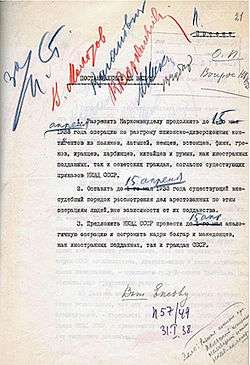Latvian Operation of the NKVD

The so-called Latvian Operation (Russian: Латышская операция) of the People's Commissariat for Internal Affairs (NKVD) was a mass arrest and execution of persons of Latvian origin in the Soviet Union during the period of Great Purge (1937–1938).
Latvians in the Soviet Union until 1936
More than 500 Latvian peasant colonies originated from the 19th century after the abolition of serfdom near St. Petersburg, Novgorod and in Siberia. As the front line of Courland was approaching in the First World War, extensive forced evacuations were carried out, so that the number of Latvians living in Russia doubled to up to 500,000 people. Many of the Latvian Riflemen were the early supporters of the Bolsheviks in 1917. With the end of the World War and the Russian Civil War, many of the refugees were able to return to an independent Latvia. The Riga peace treaty explicitly foresaw the departure of former Latvian riflemen and refugees. According to the 1926 census, about 150,000 Latvians lived in the Soviet Union. They cultivated a lively cultural life with the schools, newspapers and theaters. Since the 1905 Revolution, there has been a strong Latvian faction in the Russian Social Democratic Labour Party. Persons of Latvian descent temporarily held the high positions in the State apparatus of Soviet Russia. Of 70 Commissioners of the Cheka were in the year 1918 38 were of Latvian origin. However, with the increasing Russification of the State organs, members of non-Russian minorities were largely ousted from the management positions. In the party leadership of Josef Stalin, Latvia was regarded as a so-called "enemy nation" and Latvians were generally regarded as counter-revolutionary and suspicious. The resistance of peasant colonists to the forced collectivization at the end of the 1920s seemed to confirm to this image. Through targeted deportations in the Gulag, these colonies were eliminated by 1933. From this time, a rigorous "purge" of the party and state apparatus of non-Russians took place. The Latvian Communist Party was dissolved in 1936, its members persecuted and murdered as "nationalists" and "people's enemies". One aspect of the great Terror was state-directed xenophobia. In July 1937 the closure of the publishing house and Cultural association "Prometejs" and the arrest of its employees took place. The Red Latvian Riflemen were removed from the history and school books and their veteran associations were dissolved.
The Operation
On November 23, 1937, Nikolai Yezhov ordered the NKVD services to pool all the information gathered about Latvians in cultural and political life, the military and other institutions to be able to arrest them "just as during the Polish operation". On 30 November, the Order No. 49990 was the mass arrest of ethnic Latvians throughout the Soviet Union. The lawsuits were streamlined by forms with pre-printed accusations and confessions, which then condemned judicial victims to criminal work or shooting. Through torture, the NKVD constructed the existence of a Latvian espionage circle, which allegedly belonged to all Latvian officials from the Politburo to the school directors. The last Latvian Chekists were now also executed by their colleagues. Due to the large number of detainees, despite the so-called album proceedings, the courts were unable to impose convictions quickly enough. Therefore, the finish date of the action was extended until August 1938. In October 1938, special Troikas were then set up to work out the backlog of unedited cases. When the successor of Yezhov, Lavrenty Beria issued the command No. 00762 on November 26, 1938, the Latvian operation ended with the conclusion of the Great Terror. The liquidation of the Latvian party officials gave the Soviet authorities certain difficulties in establishing a party and administrative apparatus in the occupation of Latvia 1940.
Deaths resulting from the operation
In particular, 22,369 convictions of Latvians were known, of which 16,573 or 74% were shot. Various estimates are based on 73,000 Latvian casualties. Exact victim numbers are also not available because many other people were murdered under the pretext of "Latvians". Women who were sent to the gulag because of a marriage with the ethnic enemies and their children who came to orphanages were not included in the statistics. The operation led to the abandonment of their own culture among the remaining Latvians, so descendants of Latvian colonists barely speak Latvian today. A rehabilitation of the victims took place under Khrushchev. Information about the specific death and date could only be obtained after the end of the communist rule after 1990. The perpetrators and performers of the action, often known by name, have never been held accountable. Larger groups of victims were shot at the practice places Butovo and Kommunarka near Moscow, Levaschovo near Leningrad or Kurapaty near Minsk. However, the tortures and murders were carried out throughout the territory of the State.
Notable victims
See Also
References
Literature
- Pārsla Eglīte u.a.: "Latviešu akcija" PSRS 1937–1938. Museum of the Occupation of Latvia, 2007, ISBN 978-9984-9931-5-7.
- Björn M. Felder: Lettland im Zweiten Weltkrieg: Zwischen sowjetischen und deutschen Besatzern 1940–1946. Schöningh, 2009, ISBN 978-3-506-76544-4.
- Aivars Beika: Latvieši Padomju Savienībā. Komunistiskā genocīda upuri 1929–1939. In: Latvijas Okupācijas muzeja gadagrāmata; 1: 1999. Riga 2000.
- Anna Kaminsky: Erinnerungsorte an den Massenterror 1937/38: Russische Föderation. Bundesstiftung zur Aufarbeitung der SED Diktatur, 2007, ISBN 978-3-00-022887-2.
Documentary film
- Dzintra Geka: Stacija Latvieši 1937. Studija SB 2011.
External Links
- Zwei Gespräche mit dem Historiker Jānis Riekstiņš in Neatkarīga Rīta Avīze: Dezember 2011, November 2012
- http://www.memorial.krsk.ru/deu/Dokument/Ariicles/2007HrBT.htm: „Der Große Terror“: 1937–1938. Kurz-Chronik. Website von Memorial-Russland, Gebiet Krasnojarsk